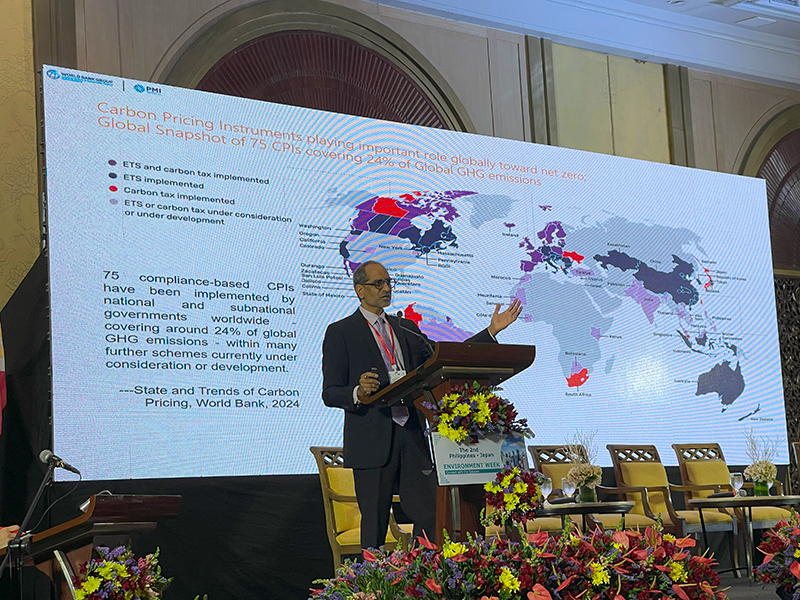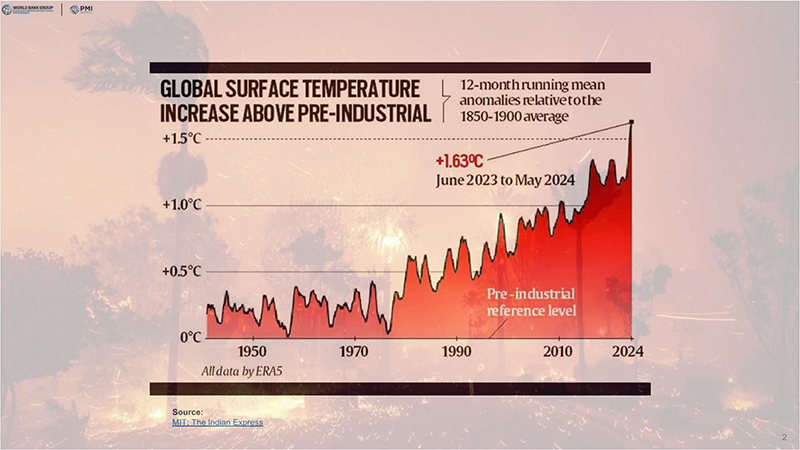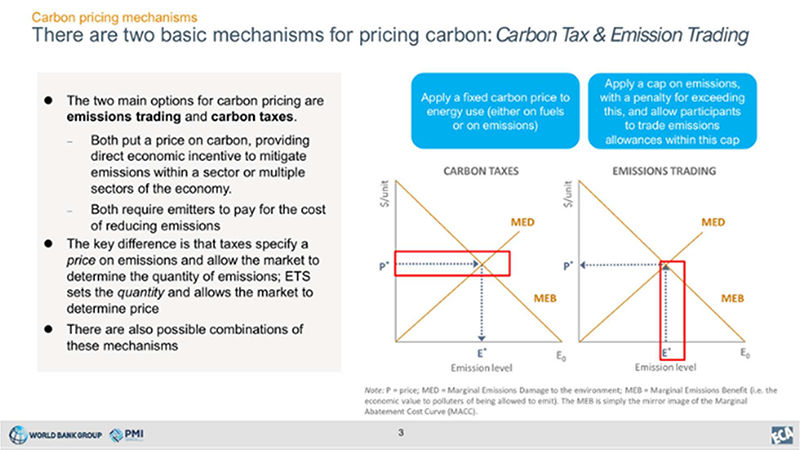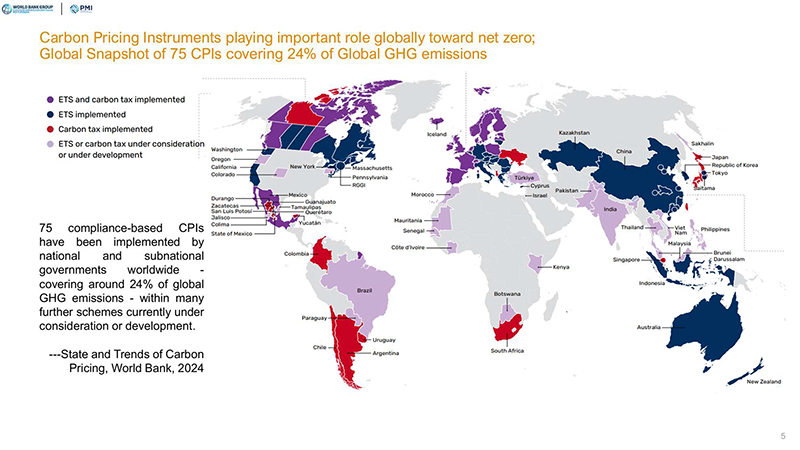Kizuna Solutions:From Events - Good Practices
2025.10
Philippines-Japan Environment Weekⅰ
Carbon Pricing in Global Spotlight
- Paving the Way to a Decarbonized Future -

| Event | The 2nd Philippines-Japan Environment Week Session: Environmental Finance(Held in January 2025) |
|---|---|
| Presenter | Dr. Pawan G. Patil Environment and Climate Coordinator for Philippines, Malaysia, and Brunei The World Bank |
| Summary | Keynote presentation on global carbon pricing system by Dr. Pawan G. Patil from the World Bank |
| Reference | https://jprsi.go.jp/files/ew2025ph/Session1/S1-2_Pawan.pdf |
Carbon Pricing Initiatives (CPI) are a mechanism that encourages companies and individuals to reduce greenhouse gas (GHG) emissions by imposing an economic cost on them. Methods include carbon taxes and emissions trading systems (ETS). It has been rapidly introduced in recent years as a policy that can promote decarbonization in a cost-effective manner.
At the 2nd Japan-Philippines Environment Week held in January 2025, Dr. Pawan G. Patil of the World Bank spoke at the Environmental Finance Session, where he discussed business opportunities related to CPI and its contribution to a sustainable society and a livable planet.
Carbon Pricing: A Lifeline for Climate Action
The Paris Agreement was adopted at the 21st Conference of the Parties (COP21) to the United Nations Framework Convention on Climate Change (UNFCCC) in 2015. It explicitly states the goal to “hold the increase in the global average temperature to well below 2℃ above pre-industrial levels” and to “pursue efforts to limit the temperature increase to 1.5℃”.
However, for the first time in history, the planet's average temperature in 2024 breached the threshold of 1.5°C above pre-industrial levels.
 |
|---|
Graph showing temperature increase from the pre-industrial era to the present |
There has never been a more important time to strengthen support for pathways towards a better future, one that is more climate resilient and where no one is left behind. Our planet is facing unprecedented environmental challenges, from rising temperatures and extreme weather events to biodiversity loss in ocean acidification. As we work towards mitigating these threats, we must explore not only the science, but also the economic incentives and policies that can drive meaningful change.
Among the most powerful economic tools available to us in the fight against climate change is carbon pricing. Carbon pricing instruments, or CPIs, are designed to hold businesses and individuals accountable for the carbon dioxide and other greenhouse gases they emit. While being simply an economic mechanism to protect the environment, they hold the potential to shape a more sustainable, equitable, and resilient society.
The Role of Carbon Tax and Emissions Trading
There are two primary types of carbon pricing instruments: carbon taxes, which directly set a price on carbon by taxing fossil fuels based on the amount of carbon dioxide they emit; and Cap and Trade systems, or Emission Trading System (ETS), in which a government sets a cap on the total emissions allowed in a given year and issues permits that companies can buy and sell—each representing the right to emit a certain amount of carbon dioxide.
Both systems share the same goal: reducing greenhouse gas emissions. However, they differ in the approaches they take and in how they bring about that change.
 |
|---|
Mechanisms of carbon taxes and ETS |
Carbon taxes create an economic incentive for businesses to reduce their carbon footprint: the higher the emissions, the higher the tax. Under ETS, companies can buy and sell permits, encouraging them to reduce emissions in order to save money or profit by selling unused permits.
CPI: A Catalyst for Change in Both the Environment and the Economy
There are five ways in which carbon pricing can forge a more prosperous and sustainable society, benefiting both businesses and nations.
①Encouraging Green Innovation
Carbon pricing provides a strong incentive for businesses to innovate and invest in cleaner technologies. This creates a marketplace for renewable energy, electric vehicles, energy-efficient solutions, and carbon capture technologies. For example, when the cost of emitting carbon dioxide increases through carbon pricing, companies in high-emission sectors such as energy, transportation and manufacturing are motivated to explore cleaner, greener and sustainable options. This could lead to accelerated development of solar and wind energy infrastructure, more efficient electric transportation systems, and carbon-neutral construction methods.
②Internalizing Environmental Costs
One of the key strengths of carbon pricing is its ability to internalize the cost of carbon emissions. Right now, environmental damage caused by carbon emissions is not reflected in the prices of goods and services. Carbon pricing corrects this by making the environmental cost part of what consumers pay. By implementing a carbon price, for example on a gasoline-powered car or gasoline itself, the true cost of those emissions can be factored in, incentivizing consumers to make more sustainable choices.
③Reducing CO2/GHG emissions at Scale
Carbon pricing provides a framework that can be adopted internationally. In fact, carbon pricing is already in place in over 40 countries, covering around 20% of global emissions.
Through mechanisms like carbon border adjustments - where carbon prices are levied on imports based on their carbon content - countries can help create a level playing field and prevent carbon leakage, where emissions are simply outsourced to regions without carbon pricing. International cooperation is certainly key to ensuring the creation of a truly sustainable global economy.
④Stimulating a Circular Economy
Carbon pricing encourages a shift from a linear, make-take-dispose economy to a circular economy, where resources are used, repaired, and recycled. When companies face higher costs for using raw materials or producing waste, they are incentivized to create products that are designed to last longer, are easier to recycle, or require fewer materials. This could lead to a dramatic reduction in resource extraction, waste, and pollution.
⑤Equity and Social Justice
The revenues generated from carbon pricing can be redistributed to help vulnerable communities. This can ensure that the transition to a low carbon economy does not disproportionately burden those that are least able to pay, but instead provides opportunities for growth, innovation and social mobility.
The Challenges and Opportunities for Carbon Pricing
While carbon pricing is a promising tool, it's not without its challenges. One concern is that carbon pricing can lead to higher costs for consumers, particularly in regions where low-carbon alternatives are not readily available. To address this, governments must use carbon pricing revenue strategically, directing funds into social programs, green infrastructure, and energy-efficient measures that reduce the burden on low-income individuals. Furthermore, for carbon pricing to work efficiently and effectively, it needs to be robust, transparent, and well-enforced. Global cooperation and consistency in carbon pricing mechanisms are essential to avoid market distortions and ensure the system's fairness and effectiveness for all businesses and nations.
Carbon pricing instruments are not just economic tools - they are powerful means of creating a sustainable society. By putting a price on carbon, we send a clear signal to the market, governments, businesses, and individuals that the cost of inaction on climate change is too high.
These instruments can encourage innovation, create economic opportunity, promote social equity, and help reduce global emissions. Many countries around the world are already implementing carbon pricing mechanisms.
 |
|---|
Countries and regions implementing CPI |
To conclude
As we face the environmental challenge of our time, we must recognize that the cost of not acting on climate change far exceeds the cost of implementing change, including carbon pricing instruments.
Through bold and ambitious policies, we can build a more sustainable, just and prosperous world for future generations.
 |
|---|
|
Speaker Introduction Dr. Pawan G. Patil An environmental economist and a serial social entrepreneur who has launched numerous environmental startups. After transitioning from the private sector to the World Bank, he has spent more than 25 years leading innovative environmental finance initiatives, such as blue bonds and debt-for-nature swaps. His research has been featured in publications like The Economist and Nature. He is currently based in Manila, where he leads climate and environmental policies in the Philippines, Malaysia, and Brunei. |
|---|
- This document has been prepared based on information deemed reliable by JPRSI. No guarantee is made as to its accuracy or completeness.
- Any profit or loss resulting from actions taken based on this document is the sole responsibility of the party taking such actions, and JPRSI shall not be held liable.
- You are free to link to this document. If you quote or cite any part of this document by other means, please clearly state "JPRSI (Japan Platform for Sustainable Infrastructure) website" as the source.
ⅰ This article is a simplified summary of Dr. Pawan G. Patil's presentation at the Environmental Finance Session of the 2nd Japan-Philippines Environment Week.

